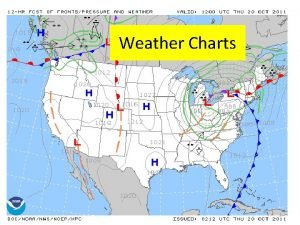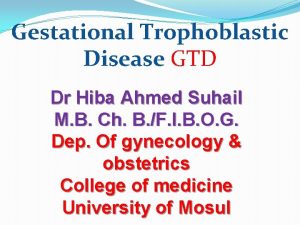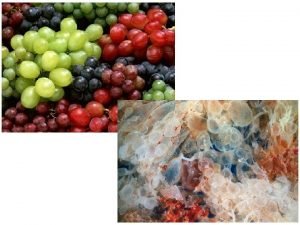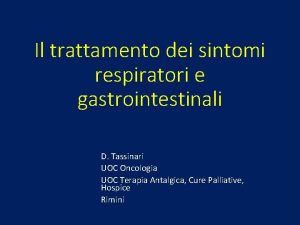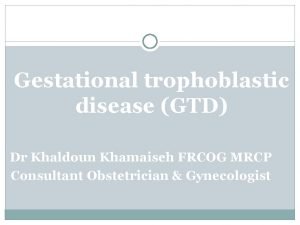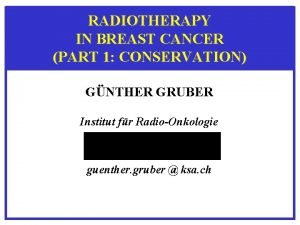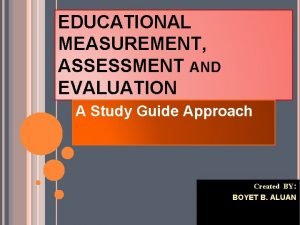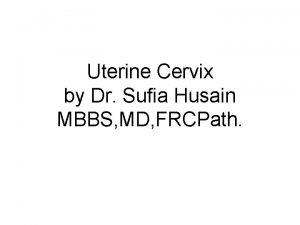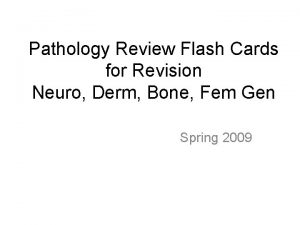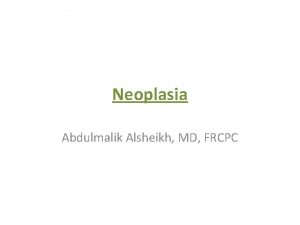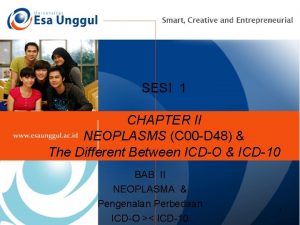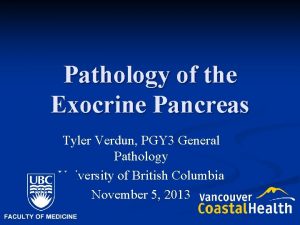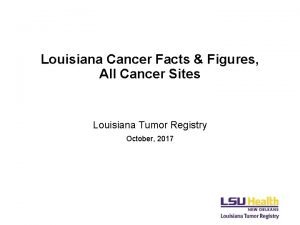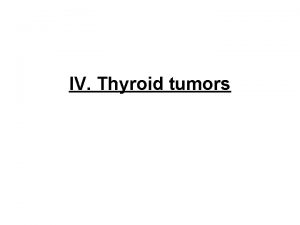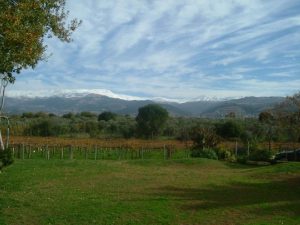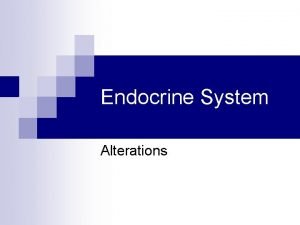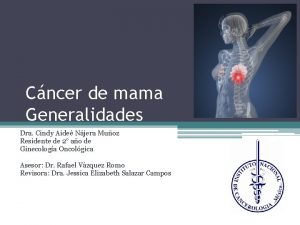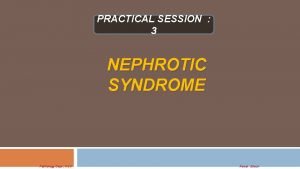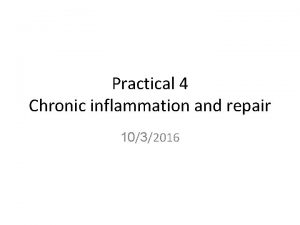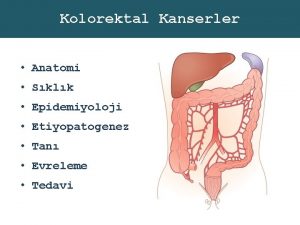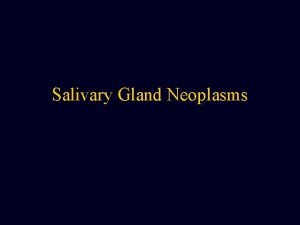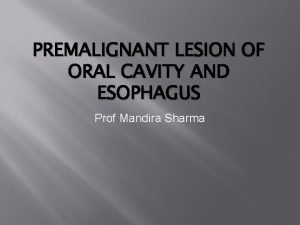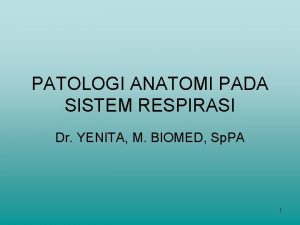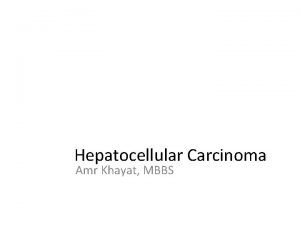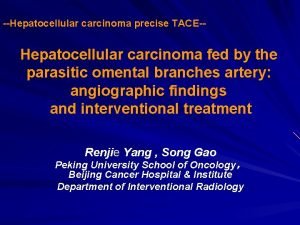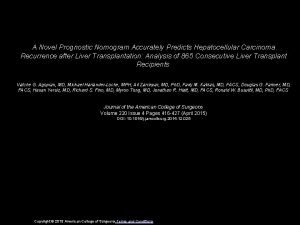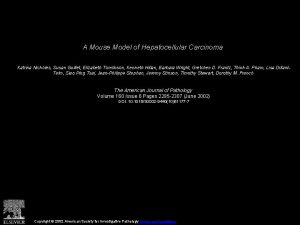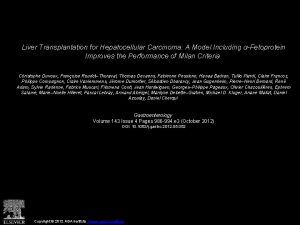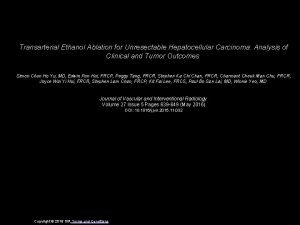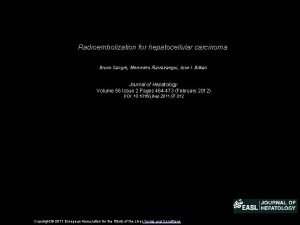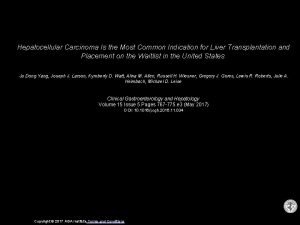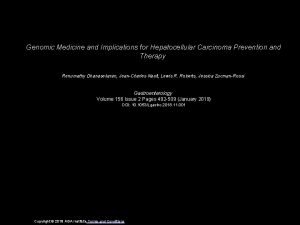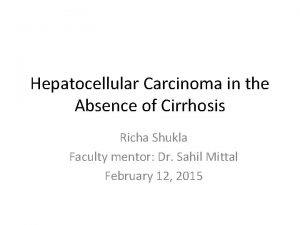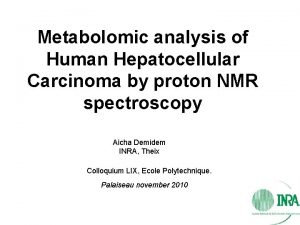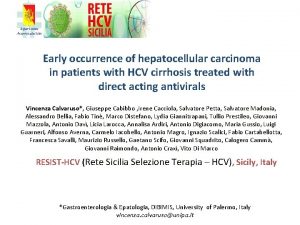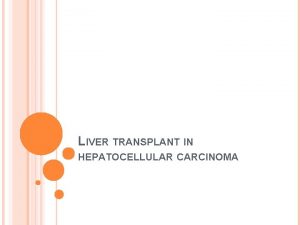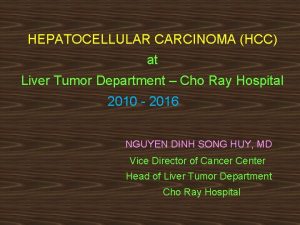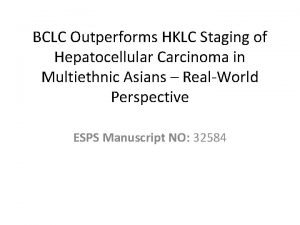Tree Structured Prognostic Model for Hepatocellular Carcinoma Taerim











































- Slides: 43

Tree Structured Prognostic Model for Hepatocellular Carcinoma Taerim Lee (1) , Hyungjun Cho (2), Hyosuck Lee (3) (1) Dept of Information Statistics Korea National Open University e-mail : trlee@mail. knou. ac. kr (2) Dept. of Biostatistics University of Maryland e-mail : hyungjun@stat. wisc. edu (3) Dept. of Internal Medicine Seoul National University e-mail : hsleemd@snu. ac. kr IMA 2003 1 KNOU

Outline 1. Background 2. Motivation & Purposes 3. Analytic structure of Tree Structured Model 4. Prognostic Model of Hepatocellula carcinoma 5. Remarks IMA 2003 2 KNOU

Background 1. Tree structured regression modeling techniques have been developed using a recursive partitioning algorithm. 2. There has been a strong need on the analyses of the data on the survival rate of patients with HCC who were treated with either with surgical resection or transaterial chemoembolization method. IMA 2003 3 KNOU

Review of Literature 1. L. G o r d e n & R. O l s h e n & (1985) presented tree structured survival analysis in the Cancer Treatment Reports. M. Segal(1988) Regression Trees for censored data 3. R. B. Davis & J. R. Anderson(1989) developed 2. exponential survival trees using a recursive partitioning algorithm for incomplete survival data using CART in Statistics in Medicine. 4. Lynn A. Sleeper & D. P. Harrington(1990) examined a flexible survival model with Regression S p l i n e s for covariate effect in Liver Disease. IMA 2003 4 KNOU

Review of Literature 5. M. Le. Blanc & John Crowley(1992) developed a method for obtaining tree-structured relative risk estimates for censored survival data. 6. M. Le. Blanc & John Crowley(1993) reported survival trees by goodness of split in JASA. 7. H. Ahn & W. Y. Loh(1994) fitted piecewise proportional hazards models to censored survival data with bootstrapping in Biometrics. 8. D. Collett(1994) reported modeling survival data in medical search. IMA 2003 5 KNOU

Review of Literature 9. W. Y. Loh & Y. S. Shih(1997) derived split selection methods for classification tree in Statistica Sinica. 10. S. H. Um et al. (1997) derived the prognostic index and define the natural stage of HCC using those index. 11. S. H. Um et al. (1998) evaluated the prognosis of HCC in relation the treatment methods. 12. S. K. Han et al. (1998) estimated the survival rate and their affecting factors in patient with HCC. IMA 2003 6 KNOU

Review of Literature 14. K. M. Kim et al. (2000) studied the survival rate of patient with hepatocellular carcinoma (HCC) who were treated either with surgical resection or transarterial chemoembolization 15. K. M. Kim et al. (2000) compare the survival and quality of life in advanced non small cell lung cancer patients in Journal of Clinical Oncology. 16. H. J. C h o (2001) reported tree structured regression modeling for censored survival data. IMA 2003 7 KNOU

Motivation 1. A variety of powerful modeling technique have been developed for exploring the functional form of effects for HCC. 2. To find the model related to the effects which are changing over time with covariate. 3. To obtain the tree structured prognostic models of HCC patients. IMA 2003 8 KNOU

Objectives 1. To identify the effect of prognostic factors of HCC. 2. To quantify the patient characteristics that related to the survival time. 3. To explore the functional form and the relationships of the covariates. 4. To reflect the changing effects over time to the prognostic model. IMA 2003 9 KNOU

Material and Method. Data : From 1993 through 1996, 186 patients with HCC in UICC T 1 -3 NOMO and liver function of Child-Pugh class A were enrolled in SNUH. . Variables : Stratification Var: Surgical Resection group Transaterial chemoembolization group Clinical Var : sex, age, afp, viral child effect UICC. CLIP # of TACE type, tumor size, lobe, inv. Transformed variables(7) Dependent Var : prognosis(sur, sc) survivalship IMA 2003 10 KNOU

Table 1. Pretreatment Base-Line Characteristics of the Patients CHRACTERISTIC SURGICAL TESECTION (N=91) TRANSCATHETER ARTERIAL CHEMOEMBOLIZATION (N=91) P VALUE Mean SD 50 10 56 10 0. 0002+ Male sex – no. (%) 76(84) 79(87) 0. 532+ Age-yr Serum alpha-fetoprotein – no. (%) 0. 756+ < 400 ng/ml 58(64) 60(66) 400 ng/ml 33(36) 31(34) Viral marker-no. (%) Hepatitis B virus 0. 046 71(78) 61(67) Hepatitis C virus 4(4) 16(18) Hepatitis B and C virus 2(2) 1(1) NBNC& 13(14) 10(11) Unknown 1(1) 3(3) IMA 2003 11 KNOU

Table 1. Pretreatment Base-Line Characteristics of the Patients CHRACTERISTIC SURGICAL TESECTION (N=91) TRANSCATHETER ARTERIAL CHEMOEMBOLIZATION (N=91) Okuda stage – no. (%) Okuda Ⅰ Okuda Ⅱ 0. 155+ 91(100) 89(98) 0(0) 2(2) UICC T stage-no. (%) UICC T 1 0. 003 17(19) 12(13) UICC T 2 63(69) 49(54) UICC T 3 11(12) 30(33) CLIP scoring-no. (%) 0. 125 CLIP 1 54(59) 39(43) CLIP 2 27(30) 34(37) CLIP 3 8(9) 16(18) CLIP 4 2(2) 1(1) CLIP 5 0(0) 1(1) Lipiodol retention pattern-no. (%) 0. 063 Compact 56(62) Non-compact 30(33) 35(38) 5(5) 0(0) Unknown IMA 2003 P VALUE 12 KNOU

Table 2. Changes in afp after Initial Treatment in afp Secreating HCC CHRACTERISTIC SURGICAL TESECTION TRANSCATHETER ARTERIAL CHEMOEMBOLIZATION P VALUE Serum alpha-fetoprotein in total alphafetoprotein secretion HCC patients N=73 N=64 0. 001+ No. (%) Decreased>50% 61(84) 33(52) Decreased 25 -50% 7(10) 10(16) Stable 0 3(4) 13(20) Increased≥ 25% 2(3) 8(13) Serum alpha-fetoprotein in alpha-fetoprotein secreting HCC patients with compact Lipiodol retention N=41 N=40 0. 137+ No. (%) IMA 2003 Decreased>50% 34(83) 25(63) Decreased 25 -50% 4(10) 6(15) Stable 0 1(2) 6(15) Increased≥ 25% 2(5) 3(8) 13 KNOU

Analysis Survival Analysis - Cox regression Tree Structured Prognostic Model Comparison between survival groups IMA 2003 14 KNOU

Analytic Structure of Survival Model Proportional Hazards Model (Cox 1972) If is the hazard rate at time y for an individual with Risk factor X, the Cox proportional hazards Model is IMA 2003 15 KNOU

Fig. 1 Survival Curves for HCC according to Treatment Group Median survival Resection : 59. 1 months TACE : 35. 5 months IMA 2003 Variables in the Model CHILD CLID TX EFFECT 16 Exp(B) 2. 67 1. 43 0. 64 0. 54 KNOU

Fig. 2 Survival Curves for HCC according to Tumor Stage IMA 2003 17 KNOU

Fig. 3 Survival Curves for HCC according to CLIP Stage IMA 2003 18 KNOU

Fig. 4 Survival Curves for HCC according to Lipidol Pattern IMA 2003 19 KNOU

Fig. 5 Survival Curves for HCC according to Child Score IMA 2003 20 KNOU

Analytic Structure of Prognostic Model total CART L X 2 >b X 1 >a X 3>c D X 4 >d D L L tree structured prognostic model with effective covariate : CART uses a decision tree to display how data may be classified or predicted. : automatically searches for important relationships and uncovers hidden structure even in highly complex data. IMA 2003 21 KNOU

Fig. 6 Tree Structured Model based on HCC data 186 147(0) 39(1) CART 39 11(0) 28(1) AFP ≤ 8. 0 1 124 CHILD≤ 5. 5 76(0) 48(1) 95 52(0) 43(1) 84 50(0) 34(1) 38 15(0) 23(1) IMA 2003 AGE≤ 713 TAENUM≤ 7. 5 TAENUM≤ 1. 5 1 147 99(0) 48(1) 46 35(0) 11(1) 11 2(0) 9(1) 29 24(0) 5(1) 0 1 23 23(0) 0(1) 0 Sensitivity 90. 0% Specificity 30. 3% Total 65. 6% 1. AFP 100. 0 2. TAENUM 88. 8 3. CHILD 61. 2 4. AGE 42. 2 5. TX 32. 1 0 22 KNOU

Fig. 7 Tree Structured Model for TACE group of HCC data CART 94 46(0) 48(1) 84 37(0) 47(1) 49 15(0) 34(1) 46 12(0) 34(1) 1 IMA 2003 INV≤ 0. 5 CHILD≤ 5. 5 TAENUM≤ 1. 5 35 22(0) 13(1) 3 3(0) 0(1) 0 10 9(0) 1(1) 0 18 SIZE≤ 3. 85 17 8(0) 14(0) 10(1) 3(1) 0 AFP≤ 10. 4 8 10 7(0) 1(1) 3(1) 1 0 23 Sensitivity Specificity Total 71. 7% 85. 4% 78. 7% 1. TAENUM 100. 0 2. AFP 87. 7 3. CHILD 72. 3 4. SIZE 59. 4 5. INV 59. 0 6. CLIP 45. 5 KNOU

Fig. 8 Tree Structured Model based for SC group of HCC SC(Surgical Resection Group) CART 92 73(0) 19(1) 19 6(0) 13(1) 1 AFP≤ 8. 0 57 TAENUM≤ 7. 5 51(0) 6(1) 0 IMA 2003 73 58(0) 15(1) 16 7(0) 9(1) 7 AGE≤ 639 9 1(0) 6(1) 3(1) 1 0 24 Sensitivity 89. 1% Specificity 67. 9% Total 82. 6% 1. AFP 100. 0 2. TAENUM 72. 6 3. CHILD 31. 1 4. AGE 7. 7 5. TX 5. 3 KNOU

Analytic Structure of Prognostic Model total FACT L X 2 >b X 1 >a X 3>c D X 4 >d D L L tree structured prognostic model with effective covariate : FACT employs statistical hypothesis test to select a variable for splitting each node and then uses discriminant analysis to find the split point. The size of the tree is determined by a set of stopping rules IMA 2003 25 KNOU

Analytic Structure of Prognostic Model total QUEST L X 2 >b X 1 >a X 3>c D X 4 >d L D L : QUEST is a new classification tree algorithm derived from the FACT method. It can be used with univariate splits or linear combination splits. Unlike FACT, QUEST uses cross-validation pruning. It distinguishes from other decision tree classifiers is that when used with univariate splits the classifier performs approximately unbiaased variable selection. IMA 2003 26 KNOU

Analytic Structure of Prognostic Model total STUDI L 1 X 2 >b X 1 >a X 3>c L X 4 >d L 5 L 4 L 3 Survival Tree with Unbiased Detection of Interaction : STUDI is a tree-structured regression modeling tool. It is easy to interpret predict survival value for new case. Missing values can easily be handled and time dependent covariates can be incorporated. IMA 2003 27 KNOU

Analytic Structure of Prognostic Model STUDI Let the survival function for a covariate Xi be Where is the cumulative baseline hazard rate. Then median survival time for and individual is defined as and the cost at a node t be is defined as IMA 2003 28 KNOU

Analytic Structure of Prognostic Model STUDI Modified Cox-Snell(MCS) residuals: for I=1, …, n Where is the estimator of the cumulative baseline hazard function. IMA 2003 29 KNOU

Covariate Type 1. n-covariate: Ordered numerical predictor used for fitting and splitting. 2. f-covariate: Ordered numerical predictor used for fitting only. 3. s-covariate: Ordered predictor used for splitting only. 4. c-covariate: Categorical predictor for splitting only IMA 2003 30 KNOU

Split Covariate Selection 1. Fit a model to n and f covariates in the node. 2. Obtain the modified Cox-Snell residuals. 3. Perform a curvature test for each of n-s-and c-covariates. 4. Perform a interaction test for each pair of ns-and c-covariates. 5. Select the covariate which has the smallest p-value. IMA 2003 31 KNOU

Bootstrap Calibration • Bootstrap estimation of a bias correction coefficient - Let (Y*, δ*) be a bootstrap sample drawn from the elements in (Y, δ). - Fit a model to (Y*, δ*, X 1, …, Xp), using only the n- and f-covariates. - Compute the p-values from the χ2 curvature and interaction tests. - Convert each p-values into an absolute normal variate z*. - For r>1, if r max {zn*, znn*} ≥ max{zs*, zc*, zss*, zcc*, zns*, znc*, zsc*}, an n covariate is selected. - Repeat the above steps over a grid of r values to estimate π(r), the probability that an n-covariate is selected. - Find r 0 such that π(r 0) equals the proportion of n-covariates of the total number of covariates used for spitting in the sample. Interpolate linearly if necessary. IMA 2003 32 KNOU

How to select the covariate with the smallest p-value? 1. If the smallest p-value is from a curvature test -select the covariate which has the smallest p-value 2. If the smallest p-value is from an interaction test -for a pair of n-covariates, select the one which yields the smaller total costs of two subnodes its parent node is split by the sample median. -for s or c covariates select the one with the smaller curvature p-value. -between n-covariates and s or c covariate select the s or c covariate. IMA 2003 33 KNOU

Unbiased covariates selection 1. Fit a medel to (Y, δ , X 1…XP) using only the n and f covariates. 2. Let Z’ = max{r 0 Z , r 0 Znn, Zs, Zc, Zss, Zcc, Zns, Znc, Zsc} select the split covariate using previous selection algorithm. n IMA 2003 34 KNOU

Split Points or Split Sets For an ordered covariate, use exhaustive search, it use sample median or sample quantiles. For a categorical covariate, use a shortcut algorithm given in Breiman et al. Pruning 1. Cost complexity prunning technique of CART. 2. Choice of tree pruning by a test sample or by cross-validation. IMA 2003 35 KNOU

Fig. 9 Tree-Structured Survival Model for HCC child ≤ 7 pafp ≤ 3810 pafp 8 ≤ 78 80 Treatment = Surgery 4 147 lobe 16 = right 65 IMA 2003 524 9 525 8 159 3 23 5 12 taeeff 9 =non-compact 67 tean 18 ≤ 6 24 17 15 taeeff 33 =non-compact 32 16 49 age 65 64 ≤ 45. 1 34 15 pafp 131 130 ≤ 7. 0 8 26 afp 262 ≤ 16. 0 17 2 1 182 36 11 19 43 37 13 263 9 36 KNOU

Fig. 10 Scatterplot or Boxplots of the MCS Resideals IMA 2003 37 KNOU

Fig. 11 Survival Curves for HCC according to Node Groups IMA 2003 38 KNOU

Fig. 12 Tree-Structured Survival Model for HCC with Surgery Pafp ≤ 5. 0 1 91 IMA 2003 2 3 34 57 39 KNOU

Fig. 13 Survival Curves for HCC with Surgery according to pafp Score IMA 2003 40 KNOU

Fig. 14 Tree-Structured Survival Model for HCC with TACE taen ≤ 7 1 91 pafp ≤ 36. 0 IMA 2003 2 3 65 26 4 5 39 25 41 KNOU

Fig. 15 Survival Curves for HCC with TACE according to Node Groups IMA 2003 42 KNOU

Remarks 1. The effects of prognostic factors of HCC were identified with the tree structured survival model. 2. The factors CHILD, the number of TACE treatment, AFP, PAFP level were common to all the models, the post AFP was specifically important to the survival time of surgical resection group and TACE treatment group. 3. Tree structured survival model with minimum SAD provide the critical values of splitting covariates for each node. IMA 2003 43 KNOU
 Post hepatic jaundice
Post hepatic jaundice Types of interviews structured semi structured unstructured
Types of interviews structured semi structured unstructured Sa-sd
Sa-sd Surface analysis chart legend
Surface analysis chart legend Who prognostic scoring system gtn
Who prognostic scoring system gtn Who prognostic scoring system gtn
Who prognostic scoring system gtn Emaco regimen
Emaco regimen Palliative prognostic index
Palliative prognostic index Figo prognostic scoring system gtn
Figo prognostic scoring system gtn Van nuys score
Van nuys score Prognostic test
Prognostic test Slidetodoc.com
Slidetodoc.com Papillary renal cell carcinoma
Papillary renal cell carcinoma Carcinoma in situ
Carcinoma in situ Carcinoma in situ
Carcinoma in situ Invasive ductal carcinoma with medullary features
Invasive ductal carcinoma with medullary features Staging of breast cancer
Staging of breast cancer Carcinoma de mama
Carcinoma de mama Carcinoma in situ
Carcinoma in situ Lobular breast
Lobular breast Icd 10 tumor gaster
Icd 10 tumor gaster Wikipedia commons
Wikipedia commons Squamous cell carcinoma louisiana
Squamous cell carcinoma louisiana Follicular adenoma
Follicular adenoma Breast papillary carcinoma
Breast papillary carcinoma Hormones
Hormones Arteria axilar
Arteria axilar Epithelial component
Epithelial component Carcinoma of stomach
Carcinoma of stomach Hospital max peralta extensiones
Hospital max peralta extensiones Hnpcc
Hnpcc Basal cell carcinoma
Basal cell carcinoma Mucoepidermoid carcinoma histology
Mucoepidermoid carcinoma histology Carcinoma
Carcinoma Epidermoid carcinoma
Epidermoid carcinoma Carcinoma comedonico
Carcinoma comedonico Carcinoma bronquioloalveolar
Carcinoma bronquioloalveolar Squamous cell carcinoma
Squamous cell carcinoma Carcinoma on scalp
Carcinoma on scalp Carcinoma renal de células claras fuhrman
Carcinoma renal de células claras fuhrman Non neoplastic epithelial disorders
Non neoplastic epithelial disorders Carcinoma bronquioloalveolar
Carcinoma bronquioloalveolar Carcinoma epidermoide microinfiltrante
Carcinoma epidermoide microinfiltrante Menopausa sintomi iniziali
Menopausa sintomi iniziali



